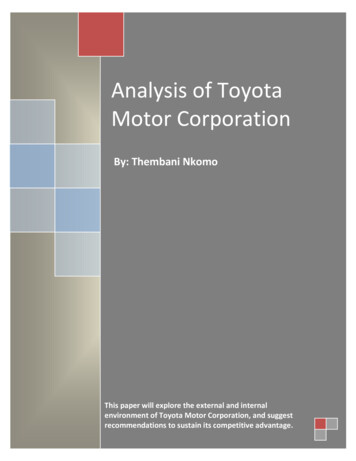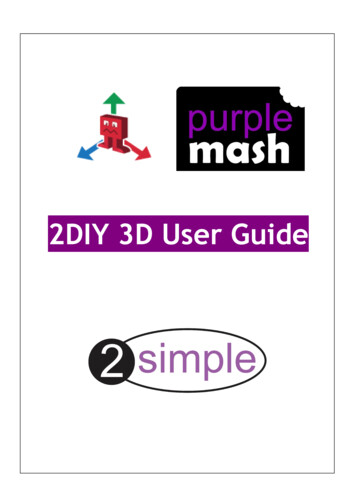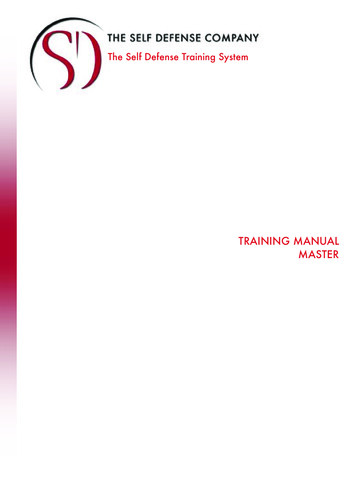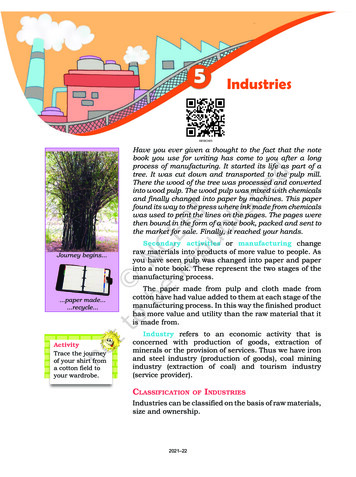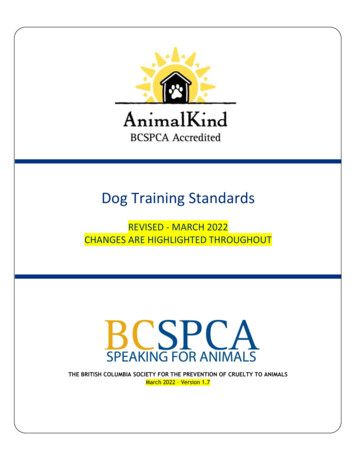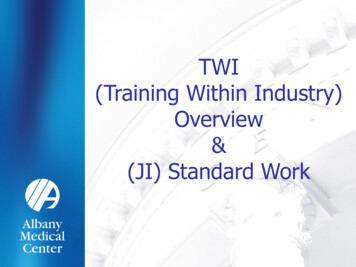
Transcription
TWI(Training Within Industry)Overview&(JI) Standard Work
AGENDA Intro to AMCHistory of Training Within Industry (TWI)Intro to TWI Job Relations (JR)Intro to TWI Job Method Improvement (JM)Intro to Job Instruction (JI)TWI and Standard WorkQ&A
Albany Medical CenterAlbany Medical Center, northeastern New York’s only academic healthsciences center, is one of the largest private employers in the CapitalRegion. It incorporates the 734-bed Albany Medical Center Hospital,which offers the widest range of medical and surgical services in theregion, and the Albany Medical College, which trains the nextgeneration of doctors, scientists and other healthcare professionals,and also includes a biomedical research enterprise and the region’slargest physicians practice with more than 450 doctors. Albany MedicalCenter works with dozens of community partners to improve theregion’s health and quality of life.
ALBANY MED LEAN HEALTHCAREDedicated to the Teaching and Practice of Lean Principles in Healthcare
AMC LEAN Belt Program Over 60 hours of LEAN & Innovation trainingOver 50 hours experiential6 booksOff site “Lean Visits”All 3 TWI classes– Job Instruction– Job Relations– Job Method Improvement
What is TWI?TWI is a Leadership Developmentprogram designed to provide supervisorsand team leaders with the ability to lead(JR), instruct (JI) and improve themethods (JM) of their jobs
iesSKILLKNOWLEDGETWI: Five Basic Needs of aSupervisor (Team Leader)Leadingwww.TWI-Institute.org
United States enters WWII (1941)Off went thousands of our skilled workforce
ProblemWho is going to manufacture to support the effort?
Women recruited to enter theworkforce (manufacturing)
And enter they did .Skills needed?
War Manpower Commission & TWI Service Developed for WWII starting in 1940. By Presidential orderApril 18, 1942 Training within Industry functions were madepart of the War Manpower Commission Mission: Support 11 million Soldiers to become the “Arsenalof Democracy” Trained over 1.7 Million peopleat 16,511 companies in the US alone
THE ROOTS OF TWIWWI SHIP BUILDING INDUSTRY The need to rapidly produce ships for the WW I meant an urgent requirement to trainworkers for the ship building industry. The Defense department initiated a training program to increase the number of shipyardworkers to 10 times the current number. They engaged Charles R. Allen, a vocational instructor from Massachusetts, to run thetraining program. Allen’s 4-step system for training new workers – Show, Tell, Do, Check – and his methodfor breaking down a job into a series of steps for training was documented in his 1919book “The Instructor, The Man and The Job”. The 4-step method clearly formed the basis for the TWI programsdeveloped over 20 years later as the US entered WWII
Impact of TWI on War EffortOf the 600 client companies monitored by theTWI Service throughout the war:86% increased production by atleast 25%100% reduced training time by25% or more88% reduced labor-hours byover 25%55% reduced scrap by at least25%100% reduced grievances bymore than 25%www.TWI-Institute.org
Industry Abandoned TWI in 1945 Millions of people returned to their jobs afterleaving the military displacing TWI trainedpeople. Viewed TWI as being a “war program”. US infrastructure was not damaged enablingmanufacturers to quickly produce consumergoods.www.TWI-Institute.org
How TWI Ended up in Japan US Occupational Government introduced TWI along with qualitymethods (Deming and Juran) in Japan (late 40’s) Japanese industry, eager to learn from the industrial base that haddefeated them, quickly made TWI a staple of their industrial trainingkeeping the training alive to this day. Toyota embraced TWI in 1951 to train their people in the evolvingToyota Production System where JI remains as a cornerstone oftheir team leader training and standard work.www.TWI-Institute.org
TWI and ToyotaToyota adopted TWI in the early 50’sThey still use it today, almost unchangedOne of the foundations of TPS, or LeanManufacturing
The 3 TWI programs work togetherlike a three-legged stool JI – Standard Work JR – Respect for People JM – Continuously ImproveHow many people have received any Supervisory training?www.TWI-Institute.org
The TWI Cycle Build strong relationships with people (JR)– so that . People will follow our good instruction (JI)– so that We create standard work and build a strongfoundation for continuous improvement (JM)– so that We can coach people to think forthemselves and be creativewww.TWI-Institute.org
Why Job Relations?
Job Relations Training (JR)Trains supervisors/team leaders on how to evaluateand take proper actions to solve and to preventproblems with people.www.TWI-Institute.org
ingQualityCostsSafetyA Supervisor Gets Results Through People
Foundations for Good Relations Let Each Worker Know How He or Sheis Getting Along Give Credit When Credit is Due Tell People in Advance About Changesthat will Affect Them Make Best Use of Each Persons AbilityRespect for Peoplewww.TWI-Institute.org
How to Handle a ProblemDEFINE YOUR OBJECTIVEStep 1 - Get The FactsGet opinions & feelingsStep 2 - Weigh And DecideWhat possible actions are there?Step 3 - Take ActionDon’t pass the buckStep 4 - Check ResultsDid your action help production?DID YOU ACCOMPLISH YOUROBJECTIVE?www.TWI-Institute.org
Job Methods Training (JM)Trains supervisors/team leaders on how toanalyze jobs to make the best use of the people,machines, and materials now available.www.TWI-Institute.org
How to Improve MethodsStep 1 — BREAK DOWN THE JOBList all details as done in the Current MethodStep 2 — QUESTION EVERY DETAILWhy, What, Where, When, Who, HowStep 3 — DEVELOP THE NEW METHODEliminate, Combine, Rearrange, SimplifyStep 4 — APPLY THE NEW METHODUse it until a better way is developedwww.TWI-Institute.org
JM Job BreakdownJob Methods Breakdown SheetCombineWrite them down, don’t try to JECTS/SAFETYIDEASWHYREMARKSPRESENT/PROPOSEDMETHOD DETAILSSimplifyDATE:RearrangeMADE BY:DEPARTMENT:DistanceDetail #PRODUCT:OPERATIONS:
Recent JM Example
Job Instruction Training (JI)How to teach people to quickly learn to do a jobcorrectly, safely, and conscientiously.www.TWI-Institute.org
Not Inconsequential
“If the worker hasn’t learned,the instructor hasn’t taught”“If the worker hasn’t learned,the instructor hasn’t taught”“If the worker hasn’t learned,the instructor hasn’t taught”
You have the SOP .
We gave you the instructions https://www.youtube.com/watch?v qZl44TBIXOc
Why do we need a standardizedtraining process?
PROBLEM: Telling Alone
Problem: Showing alone
JI How to Get Ready to Instruct1 — MAKE A TIMETABLE TO INSTRUCTWho to train, For which work, By what date 2 — BREAK DOWN THE JOBList Important StepsSelect Key PointsSafety factors are always Key Points3 — GET EVERYTHING READY4 — ARRANGE THE WORKSITEwww.TWI-Institute.org
JI 4-Step MethodStep 1 — PREPARE THE WORKERGet the person interested in learning the jobStep 2 — PRESENT THE OPERATIONDon’t give them more information than they canmaster at one timeStep 3 — TRY-OUT PERFORMANCEMake sure the person understandsStep 4 — FOLLOW UPCheck on the person frequently/Encourage questions”If the worker hasn’t learnedthe instructor hasn’t taught.”www.TWI-Institute.org
TWI Job InstructionQuickly training employees to do a jobcorrectly, safely, and conscientiously
Sustain ImprovementsOR 2 Year Changeover Trends
Why Standardize?
Why Standardize?To standardize a method is to choose out of many methodsthe best one, and use it. .What is the best way to do athing? It is the sum of all the good ways we havediscovered up to the present. It, therefore becomes thestandard.Henry Ford 1926
Standard work here?
Standard Instruction, StandardProcessesPhoto of Job InstructionDemonstration in May 1943www.SME.orgAlbany Med 2015
“Most companies have focused too heavily ontools without understanding lean as an entire systemthat must permeate an organization’s culture.”The Toyota Way, Jeffrey K. LikerContinuousImprovementContinuous ImprovementPull/KanbanTWI “Mortarbetween theHouse ofLeanPOUSCellular/FlowQuality at SourceStandardized WorkVisualQuick ChangeoverBatch Reduction5S orgLayout46
Training Within Industry Variability Causing UnstablePerformanceReduce Variability WithStandard WorkImprove Performance FromStable BaselineJob Instruction- Develop Standard- Train Each PersonJob Methods- Question Every Detail- Improve StandardJob Relations-Encourage Innovation- Solve People Problems
Impact of Tactical LeanOutputEvent #3What Standard should beEvent #2MaintenanceWhat Standard should beEvent #1MaintenanceCurrent MethodTimeThings tend to go backto where they werebefore the changewhen people are nottrained to standard.www.TWI-Institute.org
TWI Training Structure 5 days – 2 hours per day 8 – 10 Participants Each Participant Demonstrates “Learn byDoing”
TWI - 4 STEP METHOD
ResourcesThe TWI Workbook: EssentialSkills for SupervisorsProductivity Press, Shingo Prize 2007Patrick Graupp and Robert J. WronaImplementing TWI: Creating andManaging a Skills Based CultureCRC Press, October 2010Patrick Graupp and Robert J. WronaThe Roots of LeanLean Frontiers, 2014Jim HuntzingerGetting to Standard Workin HealthcareCRC Press, October 2012Patrick Graupp and Martha Purrier
What is Engagement?
Questions?Don Wiesenforth, MBAAssistant Director Center for InnovationAlbany Medical Center43 New Scotland Avenue, A161Albany, NY 12208P 262-1655C 813-1460
Albany Medical Center, northeastern New York’s only academic health sciences center, is one of the largest private employers in the Capital Region. It incorporates the 734-bed Albany Medical Center Hospital, which offers the widest range of medical and surgical services in the regi
